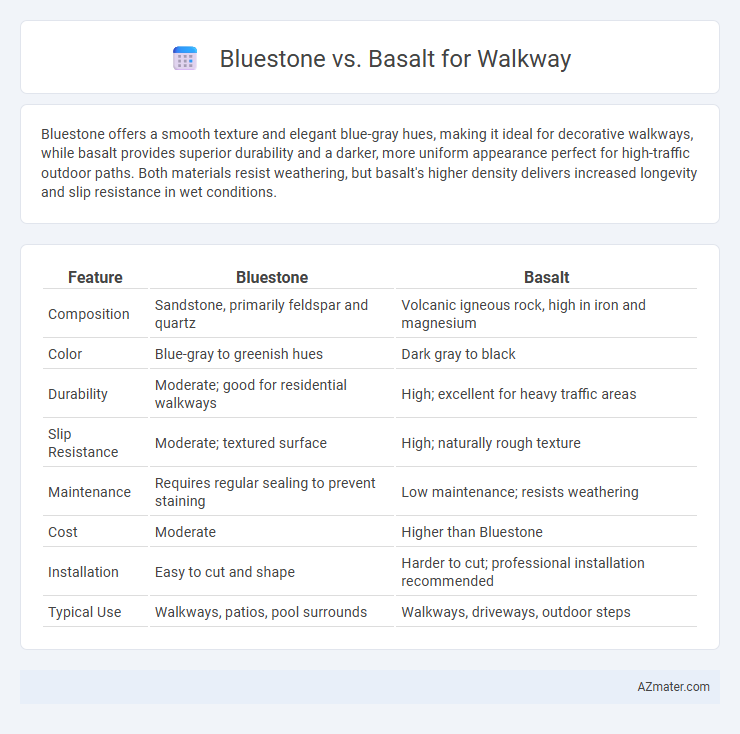Bluestone offers a smooth texture and elegant blue-gray hues, making it ideal for decorative walkways, while basalt provides superior durability and a darker, more uniform appearance perfect for high-traffic outdoor paths. Both materials resist weathering, but basalt's higher density delivers increased longevity and slip resistance in wet conditions.
Table of Comparison
| Feature | Bluestone | Basalt |
|---|---|---|
| Composition | Sandstone, primarily feldspar and quartz | Volcanic igneous rock, high in iron and magnesium |
| Color | Blue-gray to greenish hues | Dark gray to black |
| Durability | Moderate; good for residential walkways | High; excellent for heavy traffic areas |
| Slip Resistance | Moderate; textured surface | High; naturally rough texture |
| Maintenance | Requires regular sealing to prevent staining | Low maintenance; resists weathering |
| Cost | Moderate | Higher than Bluestone |
| Installation | Easy to cut and shape | Harder to cut; professional installation recommended |
| Typical Use | Walkways, patios, pool surrounds | Walkways, driveways, outdoor steps |
Introduction to Bluestone and Basalt
Bluestone, a dense and durable sandstone, is prized for its smooth texture and rich blue-gray hues, making it an ideal choice for elegant and slip-resistant walkways. Basalt, a volcanic igneous rock, offers exceptional hardness and dark charcoal to black coloring, providing a modern and sturdy option for high-traffic pathways. Both stones boast natural durability and weather resistance, ensuring long-lasting walkway surfaces with distinct aesthetic appeals.
Key Physical Properties Compared
Bluestone features a dense, fine-grained texture with moderate hardness and excellent slip resistance, making it ideal for walkways that require durability and safety. Basalt, characterized by its volcanic origin, offers superior strength, high compressive resistance, and a naturally dark color that resists staining and fading over time. Both stones provide strong weather resistance, but bluestone's slightly softer surface can be easier to shape, while basalt's toughness ensures long-lasting structural integrity for heavy foot traffic.
Aesthetic Differences: Color and Texture
Bluestone exhibits a smooth, uniform texture with a range of blue-gray hues that can include hints of green or brown, providing a sleek and elegant appearance for walkways. Basalt features a finer grain and a predominantly dark gray to black coloration, offering a more dramatic and contemporary aesthetic. The choice between bluestone and basalt for walkways profoundly influences the visual impact, with bluestone favoring warmth and subtle variation while basalt emphasizes boldness and consistency.
Durability and Longevity
Bluestone and basalt are both durable natural stones commonly used for walkways, but basalt typically offers superior hardness and resistance to wear due to its volcanic origin, making it less prone to chipping and cracking over time. Bluestone, a dense sandstone, provides good durability but may be more susceptible to surface erosion and weather-related wear in high-traffic or harsh climate areas. For long-term longevity, basalt's low porosity and strong mineral composition contribute to better resilience against freeze-thaw cycles and heavy foot traffic.
Slip Resistance and Safety
Bluestone offers a naturally textured surface that provides excellent slip resistance, making it a safe choice for walkways, especially in wet conditions. Basalt, while also durable, tends to have a smoother finish which can become slippery when wet, posing a higher risk for slips and falls. Choosing bluestone enhances safety in high-traffic outdoor walkways due to its superior grip and traction.
Installation and Maintenance Requirements
Bluestone requires professional installation due to its natural cleft texture, which demands precise leveling and secure fastening to prevent shifting, while basalt's dense, smooth surface allows for easier cutting and fitting by DIY enthusiasts. Maintenance of bluestone involves regular sealing to protect against staining and weathering, whereas basalt's low porosity reduces the need for frequent sealing and simplifies cleaning. Both materials resist frost damage, but basalt's hardness translates to greater long-term durability with less upkeep.
Cost Comparison
Bluestone typically costs between $15 and $30 per square foot, making it a more affordable option for walkways compared to basalt, which ranges from $25 to $45 per square foot due to its denser composition and limited availability. Installation expenses for basalt are often higher because of its weight and hardness, requiring specialized tools and labor. Budget-conscious homeowners frequently choose bluestone for its balance of durability and cost-efficiency in walkway projects.
Environmental Impact
Bluestone and basalt both offer durable options for walkways with distinct environmental impacts. Bluestone is a natural sandstone that requires less energy-intensive processing compared to basalt, reducing its carbon footprint during quarrying and fabrication. Basalt, an igneous volcanic rock, is abundant and locally sourced in many regions, minimizing transportation emissions but involves higher energy consumption during extraction and shaping processes.
Popular Applications for Walkways
Bluestone and basalt are popular choices for walkways due to their durability and aesthetic appeal. Bluestone, with its smooth texture and natural blue-gray hues, is often used in residential pathways, garden paths, and patios for a classic, elegant look. Basalt, known for its dense, dark appearance and slip-resistant surface, is favored for commercial walkways, public parks, and high-traffic areas requiring robust, long-lasting stone.
Choosing the Right Stone for Your Walkway
Bluestone offers a smooth, refined surface with a consistent blue-gray hue, ideal for elegant walkways requiring a uniform look, while basalt provides a tougher, darker, and more textured option suited for modern, rustic paths needing durability and slip resistance. Evaluate factors such as climate resilience, maintenance requirements, and aesthetic preferences to determine the best fit for your outdoor space. Prioritize stone hardness and porosity levels, as basalt is denser and less porous, making it more stain-resistant compared to the softer, more porous bluestone.

Infographic: Bluestone vs Basalt for Walkway
 azmater.com
azmater.com